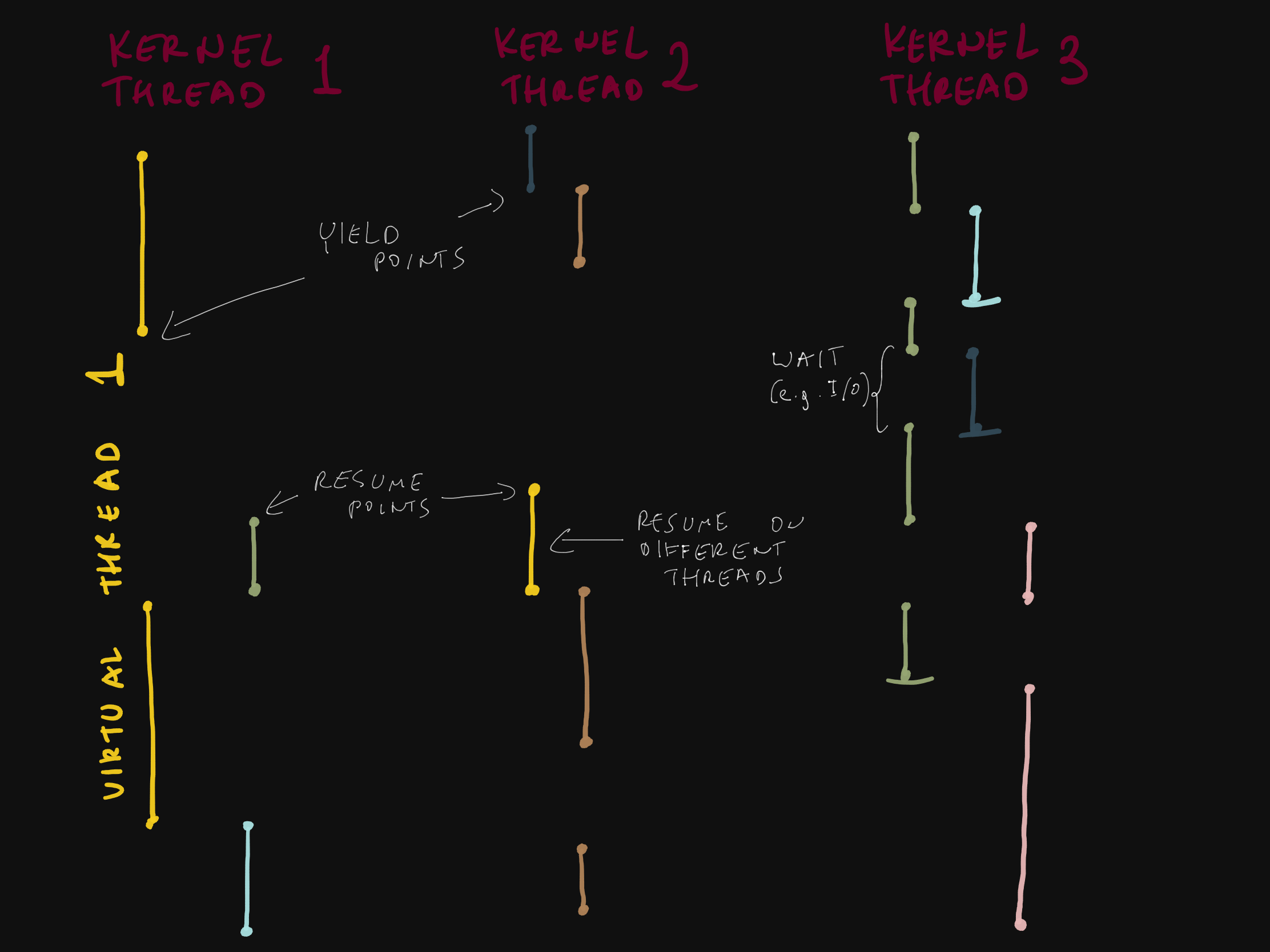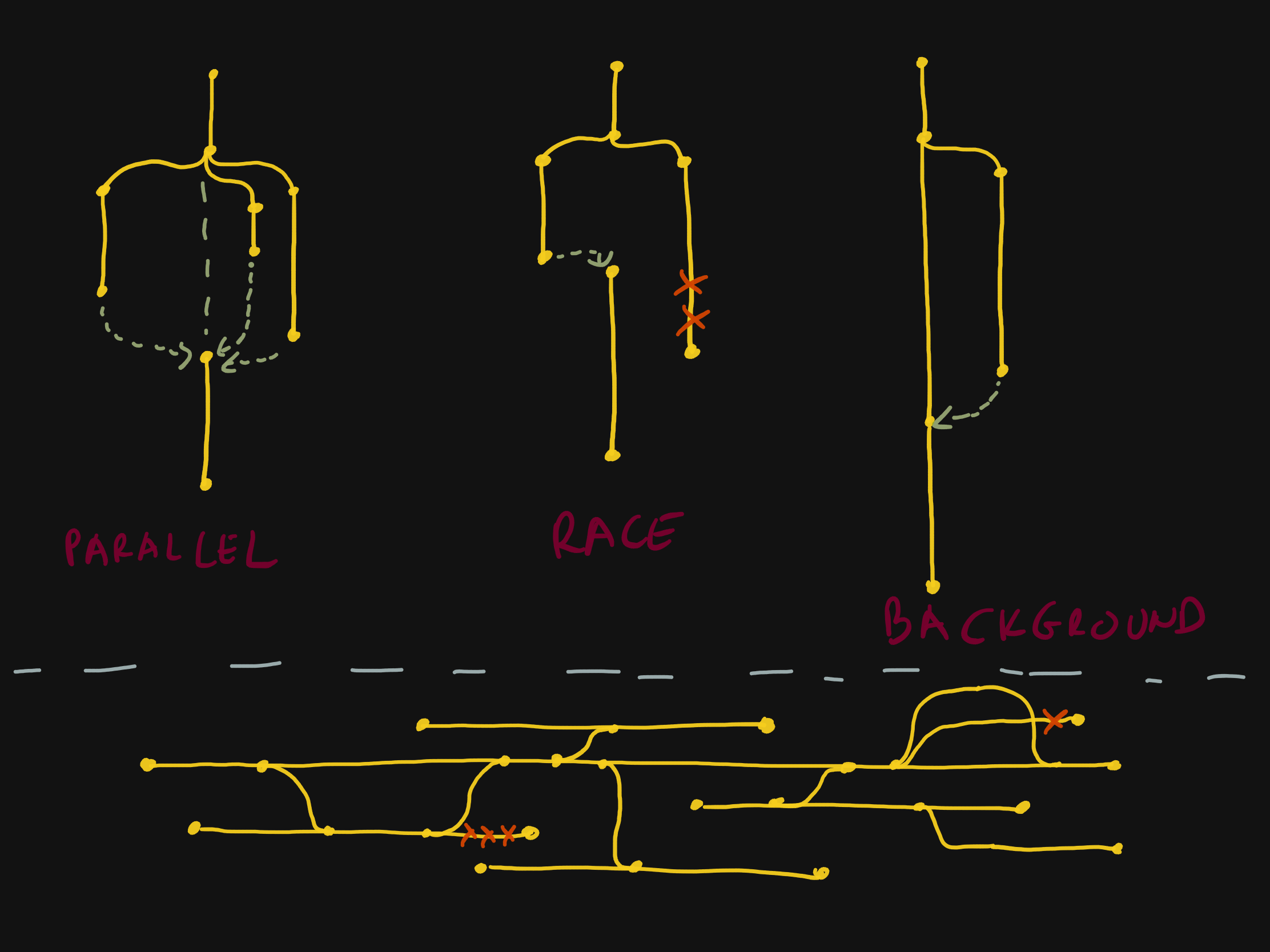Project Loom? Better Futures? What's next for concurrent programming on the JVM
Adam Warski (@adamwarski), SoftwareMill
Scale By the Bay, November 12th, 2020

The problem
We want to concurrently run multiple processes.
Concurrency examples
- http requests
- processing messages from a queue
- integrating external services
- orchestrating workflows
- background jobs
- ...
Concurrency
We'd like to create a large number of processes in a cheap way.
- it's necessary
- it's easier
On the JVM / in Java
Currently, the basic unit of concurrency is a Thread.
Threads map 1-1 to kernel threads:
- expensive to create (time & memory)
- expensive to switch (time)
- limited in number (stack memory)
Who am I?
- Co-founder of SoftwareMill
- 15 years developing backend applications
- J2EE, Spring, manual concurrency, Akka, FP
-
Our expertise
- distributed systems, messaging, blockchain, ML/AI, big/fast data, ...
- Scala, Kafka, Cassandra consulting
-
Open-source contributor
sttp client, sttp tapir, quicklens, Hibernate Envers, ...
Current solutions
Thread pooling
- created upfront
- expensive to switch
- limited in number (stack memory)
- we have to deal with threads
Current solutions
CompletableFuture<T>
A value, representing a computation running in the background.
Eventually, the computation will yield a value of type T or end with an error.
- cheap to create
- cheap to switch
- unlimited in number (heap memory)
Composing futures
var f1 = CompletableFuture.supplyAsync(() -> "x");
var f2 = CompletableFuture.supplyAsync(() -> 42);
var f3 = f1.thenCompose(v1 ->
f2.thenApply(v2 -> "Result: " + v1 + " " + v2));
var f = CompletableFuture
.supplyAsync(() -> 42)
.thenCompose(v1 ->
CompletableFuture.supplyAsync(() -> "Got: " + v1));
Life used to be simple ...
boolean activateUser(Long userId) {
User user = database.findUser(userId);
if (user != null && !user.isActive()) {
database.activateUser(userId);
return true;
} else {
return false;
}
}
... not anymore
CompletableFuture<Boolean> activateUser(Long userId) {
return database.findUser(userId).thenCompose((u) -> {
if (u != null && !u.isActive()) {
return database.activateUser(userId)
.thenApply((r) -> true);
} else {
return CompletableFuture.completedFuture(false);
}
});
}
Problems with Future
- lost control flow
- lost context
- viral
Enter Project Loom
Project Loom aims to drastically reduce the effort of writing, maintaining, and observing high-throughput concurrent applications that make the best use of available hardware.
What is Loom?
Virtual threads
-
just like threads, but cheap to create and block
Thread t = Thread.startVirtualThread(() -> { ... }); - in other languages: fibers, goroutines, coroutines, processes, green threads ...
What is Loom?
Retrofit
- existing kernel-thread-blocking operations become non-blocking
- or rather, blocking virtual threads
What is Loom?
Retrofit examples
InputStream inputStream = null;
inputStream.read();
Writer writer = null;
writer.write("Hello, world");
Semaphore semaphore = null;
semaphore.acquire();
Thread.sleep(1000L);

What is Loom?
Also:
- continuations (low-level)
- tail-call elimination (later)
State of Loom
- started in 2017
- exploratory / research project
- currently in early access
- subject to change
We saw problems with sequential code
CompletableFuture<Boolean> activateUser(Long userId) {
return database.findUser(userId).thenCompose((u) -> {
if (u != null && !u.isActive()) {
return database.activateUser(userId)
.thenApply((r) -> true);
} else {
return CompletableFuture.completedFuture(false);
}
});
}
Back to the old days
boolean activateUser(Long userId) {
User user = database.findUser(userId);
if (user != null && !user.isActive()) {
database.activateUser(userId);
return true;
} else {
return false;
}
}
Too good to be true?
A virtual thread is still a thread.
Problems with threads
- communication
- orchestration
- interruption

Thread communication / synchronization
- semaphores
- locks
- queues / channels
Why not primitives?
- deadlocks
- race conditions
- all the reasons why concurrent programming is hard
Why futures, again?
- performance: well studied & documented
- programming model: computation as a value
One way to reduce concurrency bugs is avoiding direct thread usage.
Towards declarative concurrency
Futures give us sequential/parallel composition.
Using libraries: higher-level combinators
Fetching data in parallel: virtual threads
String sendHttpGet(String url) { ... }
String run(ExecutorService executor, long userId) {
AtomicReference<String> profileResult =
new AtomicReference<String>(null);
AtomicReference<String> friendsResult =
new AtomicReference<String>(null);
CountDownLatch done = new CountDownLatch(2);
Thread.startVirtualThread(() -> {
String result = sendHttpGet(
"http://profile_service/get/" + userId);
profileResult.set(result);
done.countDown();
});
Thread.startVirtualThread(() -> {
String result = sendHttpGet(
"http://friends_service/get/" + userId);
friendsResult.set(result);
done.countDown();
});
done.await();
return "Profile: " + profileResult.get() +
", friends: " + friendsResult.get();
}
Fetching data in parallel: futures
CompletableFuture<String> sendHttpGet(String url) { ... }
CompletableFuture<String> run(long userId) {
CompletableFuture<String> profileResult =
sendHttpGet("http://profile_service/get/" + userId);
CompletableFuture<String> friendsResult =
sendHttpGet("http://friends_service/get/" + userId);
return profileResult.thenCompose(profile ->
friendsResult.thenApply(friends ->
"Profile: " + profile + ", friends: " + friends));
}
Best of both worlds?
No style fits all use-cases
- Sometimes it's better to write "synchronous" / "blocking" code
- Sometimes it's better to operate of
Futures
Fetching data in parallel: speculation
String sendHttpGet(String url) { ... }
String run(long userId) {
CompletableFuture<String> profileResult = run(() ->
sendHttpGet("http://profile_service/get/" + userId);
);
CompletableFuture<String> friendsResult = run(() ->
sendHttpGet("http://friends_service/get/" + userId);
);
return "Profile: " + profileResult.get() +
", friends: " + friendsResult.get()));
}
Fetching data in parallel: more speculation
String sendHttpGet(String url) { ... }
String run(long userId) {
runParallel(
() -> sendHttpGet("http://profile_service/get/" + userId),
() -> sendHttpGet("http://friends_service/get/" + userId),
(profile, friends) -> "Profile: " + profile +
", friends: " + friends
);
}
Why Loom, again?
Loom gives us:
- tools to write non-blocking code in the "blocking" style
- retrofitting blocking APIs into non-blocking ones
Loom doesn't give us:
- a replacement for concurrency libraries
Another view
We can represent a process as:
- code: written using the "blocking" style
- value: which can be composed & orchestrated
Better Futures
What kind of high-level operations might we expect?
retry, runAll, first, delay, ...
Often we operate on descriptions of computations, e.g. Callable<T>.
Improved ExecutorService

Improved ExecutorService

IOs
A Future is a value representing a running computation
(eager).
An IO is a value representing a description of a
computation (lazy).
What IO offers above Callable
cancellation / interruption / uninterruptible regions
separate process definition from sequencing
explicit concurrency
equational reasoning
composability
Where Loom shines: sequential logic
- majority of "business" code
- async is a technical detail
- readability is paramount
Processes represented as code.
Where IOs shine: orchestration
- niche, but business critical code
- hard to get right
- async is a first-class citizen
- readability is paramount
Processes represented as a value.
We've just scratched the surface
We haven't discussed:
- structured concurrency
- thread locals / scope values
- reactive programming
- streaming
- actors
We've just scratched the surface
All of these will be impacted by Loom.
Loom solves some of the problems.
But doesn't eliminate the need of declarative concurrency.
Further reading
Loom team:
Blogs which expand on what we've talked about today:
- Synchronous or asynchronous, and why wrestle with wrappers?
- Will Project Loom obliterate Java Futures?
- How Loom might fit cats-effect
Structured concurrency:
Twitter threads:
Thank you!
- This presentation
- Twitter (@adamwarski)
- Our blog
- Join us
